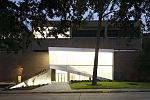The Fertitta Center, formerly known as Hofheinz Pavilion, is a 7,100-seat multi-purpose arena on the University of Houston campus in Houston. Located at 3875 Holman Street, it is home to the Houston Cougars men's and women's basketball teams and the women's volleyball team. The arena opened in 1967 as Hofheinz Pavilion, named after Roy Hofheinz and his late wife, Irene Cafcalas "Dene" Hofheinz, after they donated $1.5 million to help fund construction. Roy Hofheinz, known as Judge Hofheinz, was a UH alumnus and a Houston politician, businessman, and philanthropist. The arena is now named after restaurant magnate, Houston Rockets owner and UH alum Tilman Fertitta, who donated $20 million toward the complete renovation of the arena in 2016. The court is named for Hall of Fame and former Cougars coach Guy V. Lewis. The arena also contains an alcove dedicated to Basketball Hall of Famer Elvin Hayes, a Cougar player in the 1960s and NBA star in the 1970s. Like many arenas of its kind, the seating bowl of Fertitta Center is dug into the ground so that one enters the building at the top of the bowl.
In June 2010, the University of Houston announced a $40 million plan to renovate Hofheinz Pavilion. Ultimately in November 2015, the Board of Regents approved a $60 million complete re-design of the facility to open in 2018, funded in part by a $20 million gift from UH alum Tilman Fertitta. After the Hofheinz family objected to the building's being renamed, the school and the family reached a settlement to honor Judge Hofheinz by building a plaza containing a bronze statue of him near the facility. In addition, the UH library will archive Hofheinz's historical records in a special section. Finally, UH will petition the city of Houston to change the name of Holman Street between Cullen Boulevard and Scott Street to honor the Hofheinz family. The renovation began in March 2017 at the conclusion of the 2016–17 basketball seasons, and was scheduled to be completed in time for the 2018–19 men's and women's basketball seasons, but construction delays pushed the reopening date to December 1, 2018. Both basketball teams played their home games on the campus of nearby Texas Southern University during the course of construction.The Houston Rockets of the National Basketball Association (NBA) used the arena as their first home in Houston, from 1971 to 1975. In addition to athletics, the arena has been used for other purposes such as UH graduation ceremonies and area high school commencements. It has also hosted many concerts by famous artists. The Summit took over for much of these purposes in the city after its construction in 1975.




